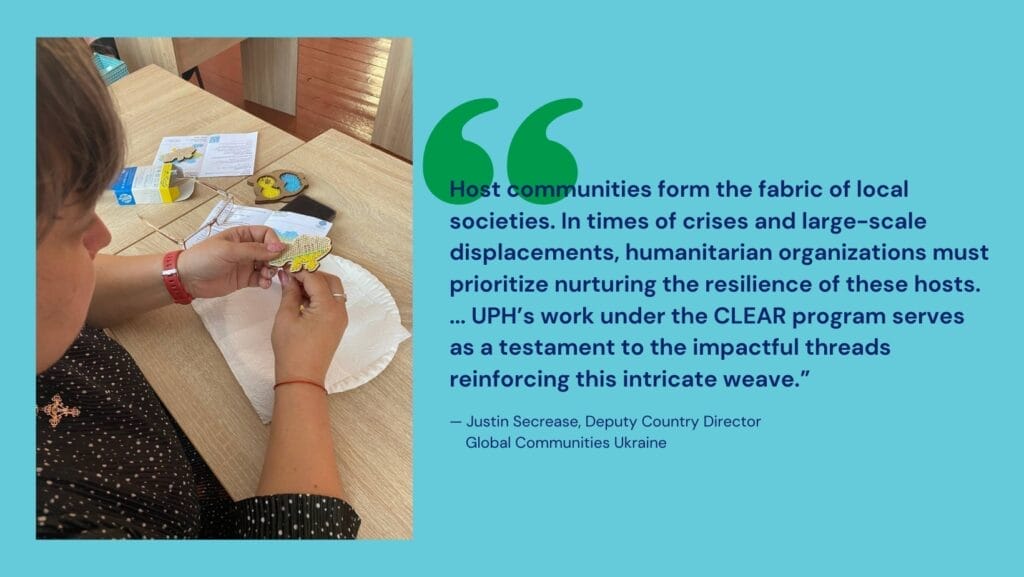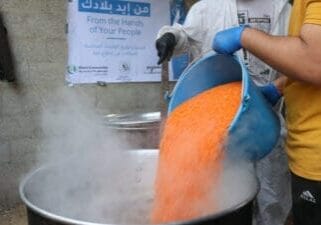News > Blog
Building Community and Supporting Internally Displaced People with Integration Efforts in Ukraine
Published 02/06/2024 by Global Communities

By Tania Dudnyk
It took eight years for Yuliia to shake off the feeling of numbness and fully integrate into the Ukrainian community where she lives now. She moved to the Chernivtsi oblast from Luhansk oblast as an internally displaced person (IDP) in 2014.
Having experienced this kind of uprooting on a personal level, Yuliia says she understands how millions of displaced people must feel as Russia continues its full-scale invasion in Ukraine. Since February 2022, Chernivtsi oblast has become one of the main refuge points for IDPs and their temporary home, or transit point, as many wait to move into other parts of Europe. To date, more than 140,000 officially registered IDPs are in the oblast.
To help respond to this population’s unique needs and assist communities in their war recovery efforts, Global Communities partnered with the U.S. Agency for International Development’s Bureau for Humanitarian Assistance (USAID/BHA) to implement the Community-Led Emergency Action and Response (CLEAR) program. CLEAR is addressing the urgent needs of 22,580 people who have been impacted by the war in Chernivtsi and Chernihiv oblasts, providing emergency response in three areas: protection, shelter & settlements, and water, sanitation and hygiene (WASH). A core strategy of the program is coordinating with local partners and civil society organizations (CSOs) to carry out this assistance, which includes hosting activities aimed at fostering social cohesion, resilience and peace.

One such partner is the Ukrainian People’s House (UPH), a CSO where Yuliia has been serving as a mobilizer since the CLEAR program began in December 2022. She helps IDPs integrate into their new communities through recreational and psychosocial support activities that allow them to interact with local residents and engage in mutually beneficial dialogue.
According to Ihor Babiuk, deputy head of UPH, inviting both parties to participate is key to the success of the approach, because it aids in clearing up misunderstandings and tensions that often arise between IDPs and locals due to cultural differences, competition for jobs and public resources. Since 2014, IDPs have moved into almost every community in the Chernivtsi oblast. Babiuk explains that frustrations between IDPs and local governments have spiked because IDPs believe the government officials are not listening to their voices, while the local governments accuse IDPs of being unwilling to work and engage in the life of the community.

Whether it be an art therapy session or cooking class, CLEAR-sponsored activities at UPH ignite conversations among participants that range from simple exchanges about regional traditions in Ukraine to more pressing matters such as job opportunities and community needs. The idea is to foster greater understanding between the two groups and bring to light the unique experiences and skills IDPs can contribute through new businesses, cultural activities, workplaces and other economic and community development efforts.
“Locals start speaking about these issues openly, as well as the IDPs. Everyone talks about assistance for the relocated population but often forget that local residents also need assistance,” Babiuk says. “Almost everyone has their own pain connected with war – a son or a husband is on the frontline, someone died or is in captivity, someone is in constant stress because of ongoing uncertainty, loss of jobs, or forced changes in habitual lifestyle.”
Babiuk admits new arrivals are not integrated into a community in a year or two – the process is long and intricate. Even so, UPH has found it helpful to seek out public activists and other CSOs that have been relocated and need assistance getting registered, learning about the community, determining activities and building connections. CLEAR also helps recruit volunteers who want to be involved with integration efforts and employs some IDPs who have professional backgrounds that are applicable and relevant.
“We try to work in such a way so that our activities do not end with the closure of a project. Our work is about people, not about figures. That is why we try to maintain continuity,” Babiuk says. “We involve IDPs, provide consultations and help them create their own CSOs. Then, they build a team and again involve IDPs in them, and our work keeps going. That is to say, [these are the] side effects of our projects. They are not foreseen, but they are of great value.”
According to Justin Secrease, Deputy Country Director of Global Communities Ukraine, UPH is a prime example of how the CLEAR program is strengthening humanitarian response by putting localization into practice — investing in CSOs which have deep knowledge of their communities and co-creating new interventions that help meet unique needs emerging from the current crisis.
“Host communities form the fabric of local societies. In times of crises and large-scale displacements, humanitarian organizations must prioritize nurturing the resilience of these hosts. Local CSOs, like UPH, emerge as critical voices advocating for the integration of IDPs, and it’s the collaborative harmony of communities and local governments that lays the foundation for managing displacement on a larger scale,” Secrease says. “UPH’s work under the CLEAR program serves as a testament to the impactful threads reinforcing this intricate weave. Yuliia’s story adds value to the collective narrative, reminding us that unity and shared experiences build resilient communities.”





